Kentucky Pest News Newsletter
HIGHLIGHTS IN THIS ISSUE
Number 1082__________Feb 20, 2002
ANNOUNCEMENTS
TOBACCO
VEGETABLES
LAWN AND TURF
SHADE TREES AND ORNAMENTALS
PESTICIDE NEWS AND VIEWS

ANNOUNCEMENTS
2006 IPM TRAINING
By Patty Lucas
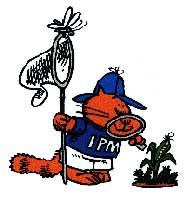 The 2006 IPM Training school will be Wednesday, March 15, at the UK Research and Education Center in Princeton. Registration will open at 8:30 a.m. with the meeting starting at 9 a.m. and ending at 3:00 p.m. The program is free of charge and lunch will be provided. To guarantee a lunch, register by March 10 by calling (270) 365-7541, ext. 216 or e-mail plucas@uky.edu.
The 2006 IPM Training school will be Wednesday, March 15, at the UK Research and Education Center in Princeton. Registration will open at 8:30 a.m. with the meeting starting at 9 a.m. and ending at 3:00 p.m. The program is free of charge and lunch will be provided. To guarantee a lunch, register by March 10 by calling (270) 365-7541, ext. 216 or e-mail plucas@uky.edu.
Program has applied for 5 hours of continuing education units for certified crop advisers - 3 in pest management, 1 in crop management and 1 in nutrient management. Educational hours have been approved for commercial pesticide applicators in the following categories: three general hours and one specific hour in category 1 - plant and animal pest control; category 4 - seed treatment; category 10 - demonstration and research pest control and category 12 - pesticide sales agent.
A copy of the program and driving directions are available from the Integrated Pest Management web page
at http://www.uky.edu/Ag/IPM/admin/school.htm.

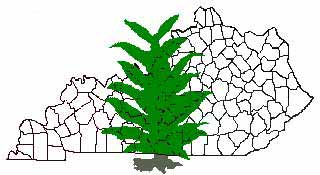
TOBACCO
2006 FUNGICIDE GUIDE FOR BURLEY AND DARK TOBACCO
By Kenny Seebold
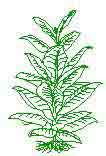 The portfolio of fungicides available to tobacco growers in Kentucky has changed somewhat from that
available in 2005. The Section 18 exemption granted for Quadris this past summer expired on
October 15, 2005. A full (Section 3) label was expected by the end of 2005 for control of frogeye
leaf spot, target spot, and blue mold; however, approval was not received until early February of
this year. According to a representative of Syngenta, the manufacturer of Quadris, the label will
issue in May and 1-2 months will be required to make the label available for public use. Given
the uncertainty, a request for renewal of last year's Section 18 will be submitted to ensure that
Quadris is available for use in the field in 2006. Results from 2005 field trials indicate that
Quadris is effective in reducing the severity of target spot and also losses in yield associated
with the disease; therefore a renewal of last year's Section 18 is warranted. Supplemental
instructions will be provided regarding Quadris as soon as they become available.
The portfolio of fungicides available to tobacco growers in Kentucky has changed somewhat from that
available in 2005. The Section 18 exemption granted for Quadris this past summer expired on
October 15, 2005. A full (Section 3) label was expected by the end of 2005 for control of frogeye
leaf spot, target spot, and blue mold; however, approval was not received until early February of
this year. According to a representative of Syngenta, the manufacturer of Quadris, the label will
issue in May and 1-2 months will be required to make the label available for public use. Given
the uncertainty, a request for renewal of last year's Section 18 will be submitted to ensure that
Quadris is available for use in the field in 2006. Results from 2005 field trials indicate that
Quadris is effective in reducing the severity of target spot and also losses in yield associated
with the disease; therefore a renewal of last year's Section 18 is warranted. Supplemental
instructions will be provided regarding Quadris as soon as they become available.
Bayer CropScience recently received a label for Aliette WDG on tobacco. Blue mold is the only disease
on the label, and Aliette is cleared for use in the greenhouse and field. The use rate for
transplant production is 0.5 lb of product per 50 gallons of water. Aliette WDG should be applied
as a broadcast spray in a volume of water sufficient to provide good coverage of foliage and
minimize contact with float-bed water or soil. According to the label, leaf burn can result if
Aliette is allowed to wash into float water or the root zone of transplants. After application,
wait 24 hours before applying any material over the top so that Aliette can be absorbed into the
foliage and to avoid washing the fungicide into float water or soil. Applications of Aliette
should begin before symptoms of blue mold appear, ideally, or when the first symptoms are observed.
Two applications can be made 5-7 days apart. For field use, apply 2.5-4 lb/A of Aliette in a
minimum of 20 gal/A of water on newly transplanted tobacco. Increase the spray volume by 20
gal/A for each week of growth until 100 gal/A is reached. The first application of Aliette should
be made immediately after transplanting and subsequent sprays can be made on a 7-to10-day
schedule. Do not exceed 4 lb/A per treatment or 20 lb/A per season (maximum of 5 applications);
the pre-harvest interval for Aliette is 3 days. Aliette should not be tank-mixed with copper
compounds, surfactants or foliar fertilizers, and the pH of the spray solution should not be less
than 6.0. Failure to observe these precautions could result in plant injury. Good spray coverage
with Aliette and other fungicides is critical to good control of disease. Our experience with
Aliette in Kentucky is limited at this time. Reports from colleagues in the Burley Belt indicate
that Aliette can be effective against blue mold if applied correctly and in a timely manner. We
will test Aliette in field trials across Kentucky during the 2006 season so that better guidance on
the efficacy of this fungicide can be provided to our growers in the future.
The following tables contain a summary of labeled chemicals that are available to growers in Kentucky for use in the production of burley and dark tobacco in 2006. Actigard or Acrobat tank-mixed with Dithane will provide reasonable control of blue mold if applied correctly and in a timely manner. BASF has introduced a liquid formulation of dimethomorph, the active ingredient found in Acrobat 50WP, called Forum for use in 2006. The liquid formulation should be easier to measure and mix than Acrobat 50WP. For suppression of black shank, use products containing mefenoxam (Ridomil Gold or Ultra Flourish) in conjunction with resistant varieties and crop rotation. Where black shank has been severe, consider making a pre-plant application at 1-1.5 pt of Ridomil Gold or 1-1.5 qt of Ultra Flourish per acre prior to transplanting. Use a volume of water or fertilizer sufficient for good soil coverage and incorporate into the top 2-4 inches of soil by disking or irrigation. Under light-to-moderate disease pressure, apply mefenoxam within 1-2 weeks of transplanting. To extend period of protection, make supplemental applications at first cultivation and layby. Do not exceed the equivalent of 1.5 lb a.i./A of mefenoxam (3 pt of Ridomil Gold or 3 qt of Ultra Flourish). Keep in mind that good soil moisture is needed for best performance of mefenoxam products against black shank. Resistance to mefenoxam (Ridomil Gold and Ultra Flourish) is widespread in populations of the blue mold pathogen, meaning that this active ingredient should not be relied upon for management of blue mold. Quadris, if approved, should provide consistent and effective control of diseases such as target spot and frogeye leaf spot; however, we have no fungicides for the moment to manage brown spot and ragged leaf spot. Dithane will suppress (but not control) frogeye leaf spot and, to some extent, target spot. For maximum effectiveness, all fungicides should be applied in a timely manner with properly configured, calibrated equipment.
As always, read all product labels carefully and follow all directions provided by the manufacturers.
Each product has specific use directions that should be followed to minimize the risk of damage to
the crop and to maximize the effectiveness of the product. Products such as Actigard can be useful
tools for disease management but can cause serious crop injury if applied incorrectly. The
following summary is provided as a general set of guidelines to aid in product selection but is
not intended to replace product labels.
| Guide to Chemicals Available for Control of Tobacco Diseases 2006 - Transplant Production |
|
| Product(s) |
Product rate |
Target diseases |
Label notes |
| Per application¹ |
Per season |
| Agricultural Streptomycin |
100-200 ppm |
no limit |
wildfire |
Outdoor beds only |
| Agri-Mycin 17 |
(1-2 tsp/gal H2O) |
no limit |
blue mold |
Apply in 3-5 gallons/1000 sq. ft. |
| Aliette WDG |
0.5 lb/50 gal H2O |
1.2 lb per 1000 sq. ft. |
blue mold |
Apply 3 gal of solution per 1000 sq. ft. on small plants; increase to a maximum of 12 gal as plants grow. |
| Dithane DF |
0.5 lb/100 gal H2O |
no limit |
blue mold anthracnose damping-off |
Apply 3-12 gallons/1000 sq. ft. as a fine spray. Begin when plants are dime-sized or larger. |
| Milk |
| Whole/Skim |
5 gal/100 gal H2O |
no limit |
tobacco mosaic virus (plant-toplant spread)- |
Apply to plants at least 24 h prior to handling. Mix will treat 100 sq. yd |
| Dry |
5 gal/100 gal H2O |
no limit |
tobacco mosaic virus (plant-toplant spread)- |
Apply to plants at least 24 h prior to handling. Mix will treat 100 sq. yd |
| Terramaster 4 EC |
1.0-1.4 fl oz/100 gal H2O |
2.8 fl oz |
damping-off (Pythium spp.) root rot (Pythium spp.) |
Apply to float-bed water no earlier than 2 weeks after seeding. Additional applications can be made at 3-week intervals. Use high rate for curative treatments; begin no sooner than 3 weeks after seeding. Do not apply later than 8 weeks after seeding. |
¹Rate range of product. In general, use higher rates when disease pressure is high. Refer to product label for application information, restrictions, and warnings.
| Guide to Chemicals Available for Control of Tobacco Diseases 2006 - Soilborne Diseases |
|
| Product(s) |
Product rate |
Target diseases |
Label notes |
| Per application¹ |
Per season |
| Fumigants |
| Chloropicrin |
60-100 lb/A (broadcast) |
-- |
black root rot, black shank |
Inject to 8-in. depth. Apply when soil temperatures are >55 °F and moisture levels are adequate. Apply a minimum of 3 weeks before setting transplants. |
| Chlor-O-Pic |
150-500 lb/A(broadcast) |
-- |
damping-off,nematodes |
Inject to 8-in. depth. Apply when soil temperatures are >55 °F and moisture levels are adequate. Apply a minimum of 3 weeks before setting transplants. |
| Telone C-17 |
10.8-17.1 gal/A (broadcast) |
-- |
bacterial wilt, black root rot |
Inject to 8-in. depth. Apply when soil temperatures are >55 °F and moisture levels are adequate. Apply a minimum of3 weeks before setting transplants. |
| Telone C-35 |
13-20.5 gal/A (broadcast) |
-- |
black shank, nematodes |
Inject to 8-in. depth. Apply when soil temperatures are >55 °F and moisture levels are adequate. Apply a minimum of3 weeks before setting transplants. |
| Non-fumigants |
| Ridomil Gold EC |
| preplant only |
2-3 pt |
3 pt |
black shank |
incorporate after application |
| preplant + layby |
2 pt + 1 pt |
| preplant + 1st cultivation +layby |
1 pt + 1 pt + 1 pt |
| Ridomil Gold SL |
| preplant only |
1-3 pt |
3 pt. |
black shank |
incorporate after application |
| preplant + layby |
2 pt + 1 pt |
| preplant + 1st cultivation +layby |
1 pt + 1 pt + 1 pt |
| Ultra Flourish |
| preplant only |
2-3 qt |
3 qt |
black shank |
incorporate after application |
| preplant + layby |
2 qt + 1 qt |
| preplant + 1st cultivation +layby |
1 qt + 1 qt + 1 qt |
¹Rate range of product. In general, use higher rates when disease pressure is high. Refer to product label for application information, restrictions, and warnings.
| Guide to Chemicals Available for Control of Tobacco Diseases 2006 - Foliar Diseases (Field) |
|
| Chemical |
Product rate |
Target diseases |
PHI² (days) |
Label notes |
| Per application¹ |
Per season |
| Agricultural streptomycin |
100-200 ppm |
no limit |
0 |
wildfire |
|
| Agristrep |
100-200 ppm |
no limit |
0 |
blue mold |
|
| Acrobat 50WP |
2-8 oz |
32 oz |
0 |
blue mold |
Increase rate and app. volume as crop size increases. Acrobat must be tank- mixed with another fungicide. |
| Actigard 50WG |
0.5 oz |
1.5 oz (3 apps.) |
21 |
blue mold |
Begin applications when plants are >18 inches in height³. Make up to 3 applications on a 10-day schedule. Apply in a minimum of 20 gal/A. |
| Dithane DF |
1.5-2 lb |
no limit |
30 |
blue mold, damping-off, anthracnose |
Apply on weekly schedule; discontinue sprays when blue mold threat no longer exists. |
| Aliette WDG |
2.5-4 lb |
20 lb |
3 |
blue mold |
Make first application immediately after trans- planting; continue on a 7-10 day schedule. Use a minimum spray volume of 20 gal/A; increase by 20 gal/A weekly to a maximum of 100 gal/A. |
| Forum |
2-8 fl oz |
30 fl oz |
0 |
blue mold |
See notes for Acrobat |
| Ridomil Gold EC/SL |
½-1 pt |
3 pt |
n/a |
blue mold |
Apply to soil at transplanting for blue mold; |
| Ultra-Flourish EC |
½-1 qt |
3 qt |
|
|
make 2nd application if needed at layby. |
¹Rate range of product PER ACRE. In general, use higher rates when disease pressure is high. Refer to product label for application information, restrictions, and warnings.
²Pre-harvest interval
³Actigard can be applied to dark tobacco varieties at the 12-inch stage.
For the latest blue mold status and other tobacco disease information, check the KY Blue Mold Warning System online.
 http://www.uky.edu/Agriculture/kpn/kyblue/kyblue.htm
http://www.uky.edu/Agriculture/kpn/kyblue/kyblue.htm

For more information about tobacco pests, visit
"Insect Management Recommendations".
VEGETABLES
USING ID-36 FOR VEGETABLE INSECT MANAGEMENT
By Ric Bessin
Although ID-36 appears to have shrunk in size with the latest edition, there is actually much more information than was contained in the past version. The difference is due to reformatting and a loss of 'white space.' With this short article, I wanted to explain some of the tables for insecticides and insect control so that users can get the most out of the publication.
How are registered insecticides/miticides listed versus listings of recommended insecticides/miticides? This is done in two separate sets of tables. Within each commodity chapter, there is a Pesticide Safety table and an Insect Control table. In the Pesticide Safety table, all of the insecticides and miticides that are registered for that commodity group are listed, whether or not they are recommended. The only exception is with some of the generic versions of insecticides as older products lose their paten protection. If I listed all of the generics, the tables would be very long indeed. Within the Pesticide Safety table, there is an note if the product is restricted use, the signal word that appears on the label, the Restricted Entry Interval (in hours), and the Pre Harvest Interval (in days). Growers often use this table to compare the Pre Harvest Intervals of recommended insecticides or miticides to select a product that is compatible with harvest schedules. If you need a product not listed in the recommended list in the Insect Control table, this is where to look.
The insecticides and miticides listed in the Insect Control tables are those that are currently recommended for specific pests on that particular commodity. Not all possible pests are listed, only those that we commonly manage on that commodity. So there may be instances, occasionally, when an unusual pest appears and an insecticide that was not listed in the recommended group is the best choice. Not all insecticides or miticides are listed in the Insect Control tables, only those recommended for that particular pest. However, just because a product is listed, it does not mean that it will provide the same level of control as all the others listed for that pest. Products may be recommended to provide for alternative modes of action to prevent/delay the development of resistance. Some products are listed as they are alternatives to Restricted Use Pesticides (RUP), because of their widespread availability across the state, or short REI for crops that need to be harvested frequently. These factors must be balanced with the level of control efficacy that is needed. The result is that there is a group of insecticides and miticides that are recommended for particular pests.
IRAC groupings and the new resistance management codes are listed on page 11 in a new table. The IRAC codes are now prominently displayed on the label of many insecticides/miticides. These codes allow uses to quickly determine which products share the same mode of action. Products that have different codes control pests in different ways. In this table, all of the common insecticdes and miticides that are used on vegetable crops grown in Kentucky are listed with their IRAC codes. This shows users the pesticide mode of action groupings to aid in the selection of products when more than one application is needed.

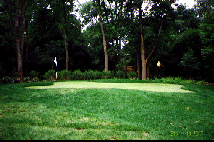
LAWN & TURF
NEW NAME FOR FUNGUS THAT CAUSES ANTHRACNOSE
By Paul Vincelli
Anthracnose is a disease of particular concern on putting greens, as the basal rot phase of this
disease can be extremely destructive to Poa annua and sometimes to creeping bentgrass. Anthracnose
also can be found on other grasses including Kentucky bluegrass, tall fescue, and perennial
ryegrass, although it is usually not highly destructive on these hosts under Kentucky conditions.
The fungus that causes anthracnose in turfgrasses and the one that causes anthracnose of corn have
been, until now, known by the same name: Colletotrichum graminicola. Corn-infecting strains don't
attack the turfgrasses, and vice versa. However, because they look so similar under the
microscope, they were considered to be the same fungal species, and went by the name
Colletotrichum graminicola.
Researchers at Rutgers (Drs. Crouch, Clarke, and Hillman) recently completed an exhaustive DNA analysis
comparing anthracnose-causing fungal isolates from corn, sorghum, and turfgrasses. Interestingly,
their paper, published last month, reports a very clear distinction between the turfgrass-infecting
strains and those that attack corn. This DNA-based distinction is so clear-cut that they have
re-named the anthracnose fungus from turfgrass, which is now known as Colletotrichum cereale.
New taxonomic names like this eventually come to replace the old names in scientific communications as
well as in trade publications, but the change doesn't happen immediately. Thus, you may read about
anthracnose in the future as being caused Colletotrichum graminicola, or you may read about it
being caused by Colletotrichum cereale. Both names refer to the same fungus; nothing has changed
except the species name. Along those lines, if a turfgrass fungicide labeled for anthracnose lists
the pathogen name, Colletotrichum graminicola, it is still legal to use the product as long as the
disease "anthracnose" is listed on the label and all other use restrictions are followed.

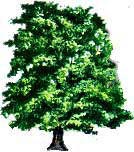
SHADE TREES AND ORNAMENTALS
OEDEMA CAN DAMAGE LANDSCAPE ORNAMENTALS AND HOUSE PLANTS
By John Hartman
Odema is a non-parasitic disorder which, under the right environmental conditions, can affect a wide variety of herbaceous plants. This problem is frequently observed on indoor plants, such as dracaena, geranium and schefflera. Oedema tends to be more of a problem in greenhouses, but it may also occur on plants grown in homes and offices as well as in the landscape. It was recently diagnosed on an English ivy specimen sent to the plant disease diagnostic laboratory. The plants were growing under irrigation and in a shady location. Field and garden grown crops, such as cabbage, may also be affected.
Cause and Symptoms. Oedema results when there is a physiological upset in the water balance in a plant. It is likely to develop when the soil is moist and warm and the air is moist and cool. These conditions are likely to exist in homes and greenhouses during periods of prolonged cool, cloudy weather in winter and early spring. A drop in air temperatures after several warm, muggy days provides ideal conditions for oedema to develop in the field. In these situations the plant absorbs water from the soil more rapidly than is lost through the leaves through transpiration. Water pressure builds up in the leaf cells, causing them to swell and to protrude as small bumps on the lower leaf surface. The cells eventually burst, giving a water-soaked appearance to the swollen areas. These swellings later become tan or brown and corky. In severe cases the corky, wart-like areas can also form on petioles and stems. If injury continues, the leaves will turn yellow, droop and fall from the plant. Plants with chronic oedema are not very valuable as house plants or landscape ornamentals.
Oedema management. Oedema can be reduced in landscapes, homes, and greenhouses by following proper cultural practices. Overwatering, high humidity and low light intensities promote the development of oedema. Therefore, avoid overwatering plants, especially during periods of cloudy weather. Improving the airflow around plants by providing adequate spacing and by regulating ventilation will help to reduce humidity. Increasing the plant's exposure to light will also be beneficial. Affected plants usually recover under favorable growing conditions.


PESTICIDE NEWS AND VIEWS
INSECTICIDE FORMULATION CHANGES
By Ric Bessin
Two vegetable insecticides are in the process of changing formulations, these are Admire and Assail. Admire 2 F is changing from a 2 F to a 4.6 Pro formulation. It will be very important for growers to note that this is a major change in concentration between the two formulations. The 2 F has 2 pounds of imidacloprid per gallon while the 4.6 Pro has 4.6 pounds of imidacloprid per gallon. The result is that it will take significantly less formulated material to mix an equivalent solution.
The other product, Assail, is changing from a 70 WP to a 30 WDG. This is also a change in concentration, but with a dry formulation. The 70 WP is a 70% wettable powder, while the 30 WDG is a 30% water dispersable granule. In this case it will take more of the new formulation to mix a solution equivalent to that made from the old formulation. As always, read to the label carefully to understand any differences between the old and new formulations.

NOTE: Trade names are used to simplify the information presented in
this newsletter. No endorsement by the Cooperative Extension Service
is intended, nor is criticism implied of similar products that are not
named.
Lee Townsend
Extension Entomologist
BACK
TO KY PEST NEWS HOME
 The 2006 IPM Training school will be Wednesday, March 15, at the UK Research and Education Center in Princeton. Registration will open at 8:30 a.m. with the meeting starting at 9 a.m. and ending at 3:00 p.m. The program is free of charge and lunch will be provided. To guarantee a lunch, register by March 10 by calling (270) 365-7541, ext. 216 or e-mail plucas@uky.edu.
The 2006 IPM Training school will be Wednesday, March 15, at the UK Research and Education Center in Princeton. Registration will open at 8:30 a.m. with the meeting starting at 9 a.m. and ending at 3:00 p.m. The program is free of charge and lunch will be provided. To guarantee a lunch, register by March 10 by calling (270) 365-7541, ext. 216 or e-mail plucas@uky.edu.



 The portfolio of fungicides available to tobacco growers in Kentucky has changed somewhat from that
available in 2005. The Section 18 exemption granted for Quadris this past summer expired on
October 15, 2005. A full (Section 3) label was expected by the end of 2005 for control of frogeye
leaf spot, target spot, and blue mold; however, approval was not received until early February of
this year. According to a representative of Syngenta, the manufacturer of Quadris, the label will
issue in May and 1-2 months will be required to make the label available for public use. Given
the uncertainty, a request for renewal of last year's Section 18 will be submitted to ensure that
Quadris is available for use in the field in 2006. Results from 2005 field trials indicate that
Quadris is effective in reducing the severity of target spot and also losses in yield associated
with the disease; therefore a renewal of last year's Section 18 is warranted. Supplemental
instructions will be provided regarding Quadris as soon as they become available.
The portfolio of fungicides available to tobacco growers in Kentucky has changed somewhat from that
available in 2005. The Section 18 exemption granted for Quadris this past summer expired on
October 15, 2005. A full (Section 3) label was expected by the end of 2005 for control of frogeye
leaf spot, target spot, and blue mold; however, approval was not received until early February of
this year. According to a representative of Syngenta, the manufacturer of Quadris, the label will
issue in May and 1-2 months will be required to make the label available for public use. Given
the uncertainty, a request for renewal of last year's Section 18 will be submitted to ensure that
Quadris is available for use in the field in 2006. Results from 2005 field trials indicate that
Quadris is effective in reducing the severity of target spot and also losses in yield associated
with the disease; therefore a renewal of last year's Section 18 is warranted. Supplemental
instructions will be provided regarding Quadris as soon as they become available.


